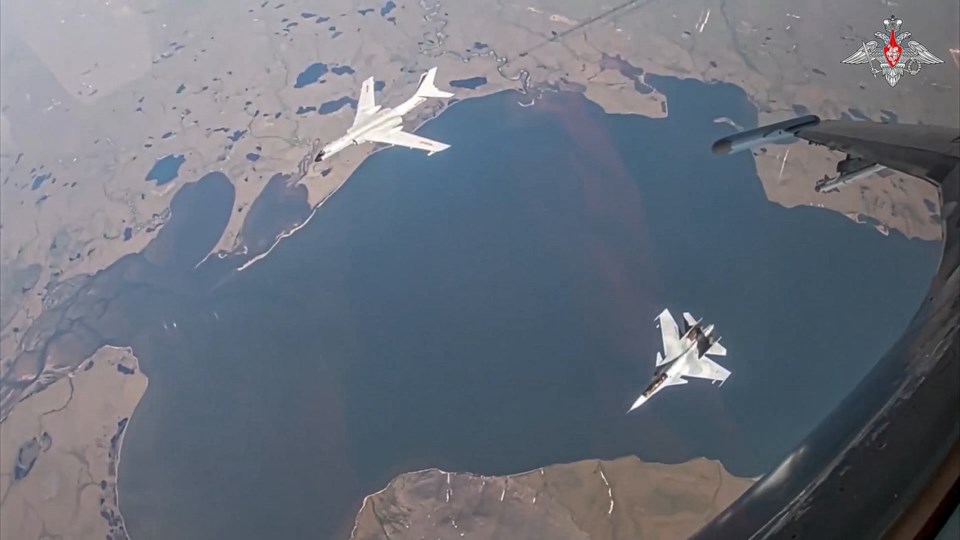WASHINGTON (AP) — Russian and Chinese bombers flew together for the first time in international airspace off the coast of Alaska, in a new show of expanding military cooperation that U.S. Defense Secretary Lloyd Austin said Thursday raises concerns.
The flights Wednesday were not seen as a threat, and the bombers were tracked and intercepted by U.S. and Canadian fighter jets. But it was the first time that Chinese bomber aircraft have flown within the Alaskan Air Defense Identification Zone. And it was the first time Chinese and Russian aircraft have taken off from the same base in northeast Russia.
“This is a relationship that we have been concerned about throughout — mostly because we’re concerned about China providing support to Russia’s illegal and unnecessary war in Ukraine," Austin told reporters.
The North American Aerospace Defense Command, or NORAD, detected, tracked and intercepted the two Russian Tupolev Tu-95 long-range bombers and the two Chinese H-6 bombers. The aircraft, said Austin, didn't enter U.S. airspace and only got within about 200 miles (320 kilometers) of the coast.
They were, however, within the ADIZ, which begins where sovereign airspace ends, and aircraft must be easily identifiable and file flight plans for authorization in order to meet national security requirements.
China and Russia both acknowledged what they called a joint patrol over the Bering Sea, which divides Russia and Alaska.
Their growing military relationship has triggered concerns both among NATO allies and with nations in the Asia-Pacific. NATO allies have called China a “decisive enabler” of Russia’s war against Ukraine through its “no-limits partnership” with Russia and its large-scale support for Russia’s defense industrial base.
The allies issues a sternly worded statement, approved by the 32 members at their summit in Washington earlier this month.
The Russian Defense Ministry said the patrol also flew over the Chukchi Sea, which is on the north side of the Bering Strait, and that the exercises lasted more than five hours.
The joint patrol tested and improved coordination between the two air forces, said Zhang Xiaogang, a spokesperson for China’s Defense Ministry. He said it was the eighth joint strategic air patrol since 2019. He declined to comment when asked if it was the first such patrol over the Bering Sea.
While Russia’s military has long been active in the north Pacific, China has emerged as a new actor in recent years as its growing navy and air force expand their presence farther from the country’s shores.
On Chinese state media, the maneuver was called “a great leap forward in the Chinese Air Force’s actual combat training capabilities,” according to Wang Mingzhi, Chinese military expert interviewed on state broadcaster CCTV. Wang cited the fact that the mission was far away from ground support as well as in unfamiliar territory, saying that it showed support's ability to operate effectively across long-range missions.
Shen Yi, a professor of international politics at Fudan University, wrote in his column that the Chinese flights were to showcase the country's deterrence, and had symbolic significance in the U.S.-China rivalry.
“China’s boosting its capabilities to carry out effective strategic gaming with the United States and to maintain strategic stability,” Shen wrote. “As this system continuously improves, it can effectively deter the U.S.”
A photo released by the Russian Defense Ministry showed a Russian Su-30 fighter jet escorting a Chinese bomber. Another photo posted online by the military channel of China's state broadcaster CCTV showed Russian and Chinese long-winged bombers flying in parallel formation against mostly blue skies.
The Japanese military has grown increasingly concerned about joint China-Russia drills and the potential threat they pose to the security of Japan and the region.
A fleet of Russian and Chinese warplanes including Tu-95s and H-6s was seen flying together last December over the waters between Japan and Korea, Japan's Defense Ministry said. At the time, China's Defense Ministry called it the seventh joint strategic air patrol with Russia.
Chinese naval ships have showed up in international waters near Alaska, most recently in mid-July when the Coast Guard spotted four ships in the U.S. Exclusive Economic Zone, which extends 200 nautical miles (370 kilometers) from the shore.
Zhang described the naval activity as routine combat readiness training and said that China would continue to conduct far-seas training to improve the capabilities of its troops.
——
AP writer Huizhong Wu contributed to this report from Bangkok.
Lolita C. Baldor And Didi Tang, The Associated Press



